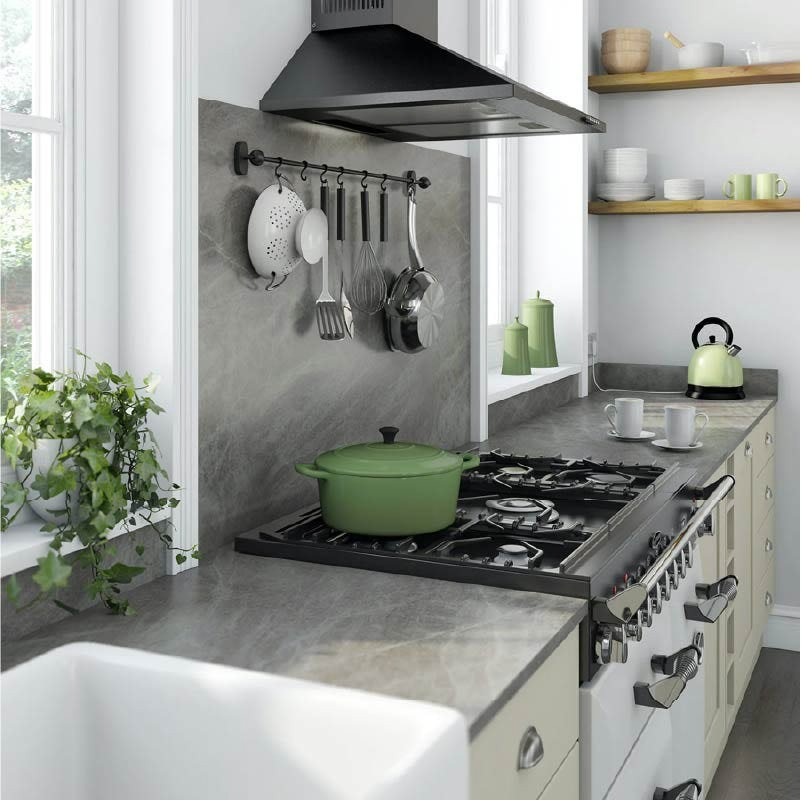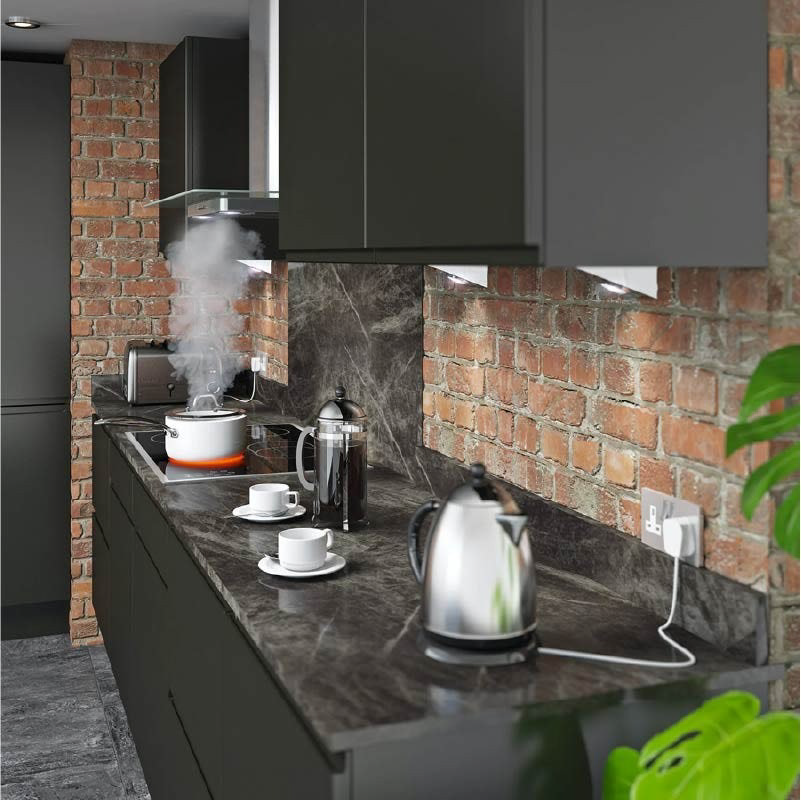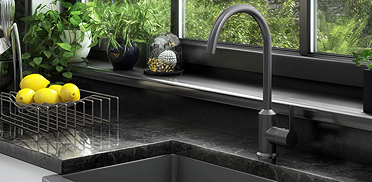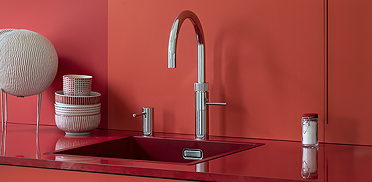OUR BOXING DAY SALE ENDS SOON!
Free delivery on orders over £499*
How to Clean a Kitchen Hood Filter
How to Clean a Kitchen Hood Filter
To help keep your kitchen functioning as it should, check out our quick and easy tips on cleaning your hood filter.

The kitchen hood that sits above your cooker stove plays an important role in maintaining a good quality of life. The filters that extract the smells, smoke, grease and other particles out of the kitchen whilst cooking help to maintain good air quality in your home, while preventing the cooker from becoming a fire hazard.
We know how to use these filters, but how do you clean them? We’ve compiled a list of some of the best cleaning tips for you to use on your filters so you can make them shine like new again.
What are kitchen hood filters?
A cooker hood filter is installed above the cooker stove and its purpose is to capture smoke, grease and debris produced during cooking and to extract it into the filtration system. If a hood filter is not in place, the grease and food particles found in smoke would build up in air ducts and could potentially become a fire hazard.
At present, it isn’t a legal requirement to have a cooker hood installed in your kitchen, although there must be some form of ventilation system in place.
However, for new homes extraction ventilation must be installed in areas of the property where there is increased humidity or pollution (such as bathrooms and kitchens). If you’re refurbishing a kitchen, there are also some things you need to be aware of:
- If you are refurbishing a kitchen without a hood already in place, you may not necessarily need one, as good ventilation may already be in place.
- If you are refurbishing a kitchen that does have extraction vents installed, then this needs to be replaced with a cooker hood, or a similar type of extraction system.
- If you are building an extension, an extraction fan system must be added to the outside of the property. The system rating will depend on where the extractor hood is being installed in the room.

What are the different types of hood filter?
There are 2 different types of fan filter systems:
Extractor hood filters
These send air outside of the property via a duct—but there is no filtering or processing involved. They are more effective than recirculation hoods because nothing is being done to the air, they do tend to be louder due to more power being used.
Recirculation hood filters
Air is pushed through the filters, removing any cooking smells produced from the stove before being recirculated back into the kitchen. They are usually cheaper than extraction fan systems, although tend to be less effective at getting rid of smoke, grease and smells.
Are cooker hood filters washable?
There are 3 types of filters on cooker hoods:
Fabric grease filters
These are designed to filter out grease and oil fumes and work a similar way to a sponge by absorbing the fumes. Because of this, fabric grease filters cannot be cleaned and must be replaced to maintain good performance levels.
Metallic grease filters
Metallic grease filters should be cleaned regularly, as the aluminium or stainless steel composition will pick up a lot of fumes and pollutants in the air. These are easy to see and usually come in the form of baffle or mesh filters.
Charcoal filters
Models without ducts that recirculate air will usually feature a charcoal filter. These types of filters cannot be cleaned and must instead be replaced every 3-4 months, depending on how much the cooker stove is used.
Why do you have to clean kitchen hood filters?
If the hood filter is not cleaned it will eventually become blocked, which could affect your quality of life at home. Because it won’t be able to extract the smoke, grease and steam into the filtration system, you stand a greater chance of being exposed to pollutants that can damage your health.
It can also lead to smoke detectors being prematurely triggered due to lingering smoke, food odours remaining in the air longer and pests like flies being attracted towards these smells.

How often should hood filters be cleaned?
Ideally, cooker hood filters should be washed every 3-4 months, although this depends on how frequently they are used. If used frequently, carbon filters should only be washed a maximum of 5 times, as they can start to lose effectiveness beyond that amount. For other types of filters, you can usually wash them up to 8 times before they will need to be changed. Once the filters stop filtering the smell from food preparation then it is time to replace them.
What is the best way to clean range hood filters?
Most instruction manuals for range hoods will tell you to isolate the electricity in the kitchen, so it is turned off before you open the hood to remove the filter. Make sure you do this before starting any deep cleaning process.
Step 1: Remove the extractor fan filters
Extractor fan filters are kept in place using different systems. Some models require you to unfasten screws, others have latch mechanisms, while others feature metal or plastic fasteners. Make sure you check to see what you need to do before you begin. If unsure, refer to the instruction manual. You should also be able to find it online if you do not have a physical manual to hand.
Step 2: Prepare the cleaning solution
There are a few different cleaning solutions you can use to remove the grime on the extractor fan filters. Below are some of the best ideas and methods for filter cleaning. It’s best to do this in and around the sink to avoid creating messy kitchen surfaces:
Dishwasher detergent
- Wet the extractor fan filter with some hot water under the kitchen tap
- Place the fan filter in the sink or a large pan
- Generously spread the detergent around the filter and let it sit in the sink for an hour
- Wash off the dishwasher detergent and grime using hot water
- Add more dishwasher detergent and then scrub the filter to get rid of all remaining traces
- If there is a lot of grease, you may have to do this a few more times to get it clean
Degreaser
Compared to using dishwasher soap, a degreaser takes a little more work to get the job done. Following these steps:
- Put the range hood filter into a large enough pan or inside the sink
- Put enough water in the pan so the filter can be submerged when placed inside
- Heat the water (although you don’t want boiling water) and add a lot of degreaser spray to the water
- Place the filter inside the water although avoid touching it with your hands
- Let it rest and soak in the water for 10 minutes at least
- Using tongs to remove the fan filter from the water and place it in the sink and wash down both sides to remove the grime until clean with a scrub brush. Wash away all the residue with hot water

Vinegar and baking soda
Vinegar and baking soda is another popular cleaning method used by people, not just for fan filters but all around the home:
- Fill up a large pot with enough water to submerge the range hood filter
- Heat it until you have boiling water
- Add 3 tablespoons of vinegar to the water followed by a 1/4 cup of baking soda. Add the baking soda carefully—once the 2 combine, it will start to fizz due to the acidity
- Put the fan filter into the boiling water and let it soak for 10 minutes at least
- Take the filter out using tongs, place it in the sink and wash down both sides to remove the grime with a scrub brush. Wash away all the residue with hot water
Baking soda and dish soap
Another option to clean your fan filters is to use baking soda and dish soap (washing up liquid) which works in a similar way to the method above:
- Fill up the sink with enough hot water to submerge the extractor filters. Using boiling water from a kettle should be enough
- Pour in a good amount of washing up liquid and a 1/4 cup of baking soda and mix the solution together
- Submerge the fan filters into the dish soap mixture and ensure they are completely covered
- Let the fan filters soak for at least 10 minutes
- Rinse the dish soap and any residue off the fan filters with hot water and repeat the process if needed
Hot soapy water and ammonia
This method is more for anyone who has been regularly cleaning their range hood grease filters as it doesn’t require much work:
- Fill the sink with warm water and dishwasher soap. You can then add ammonia to the solution
- Mix in the ammonia with until you have warm soapy water in the sink
- Clean the extractor fan filter using a brush to scrub it down and wash off all the ammonia and grime with hot water
Use the dishwasher
If you have a metallic extractor fan filter you should be able to place it in the dishwasher for cleaning. Before doing so, check the filter specifications and make sure it is safe to put inside. If you do not have this information, check online or with the manufacturer to confirm.
This is one of the easiest cleaning methods you can use and, if done monthly, will ensure you are getting the most from your oven and stove. However, if it has been left to accumulate a lot of dirt and grease over time putting it in a dishwasher is unlikely to do a good enough job. Refer to one of our methods above so it has the sort of deep cleaning it needs.
Step 3: Drying the filters
Whether placed into a dishwasher or cleaned by hand, it is always best to let an extractor fan filter air dry for a few hours before placing it back into the hood. Leaving it to air dry overnight is a good idea and, while the filter may still be a little damp, you can always use some paper towels to absorb the last bits of moisture. If you use a paper towel, make sure it is completely dry before you put in back into the hood to be used again.
Shop kitchens
From ventilation to lighting, and from kitchen sinks to kitchen taps, you'll find everything you need to serve up a seriously tasty kitchen right here at Victorian Plumbing.

Sarah
Sarah is one of our resident bathroom experts here at Victorian Plumbing. She loves writing helpful bathroom design and DIY articles, as well as detailed buying guides.


